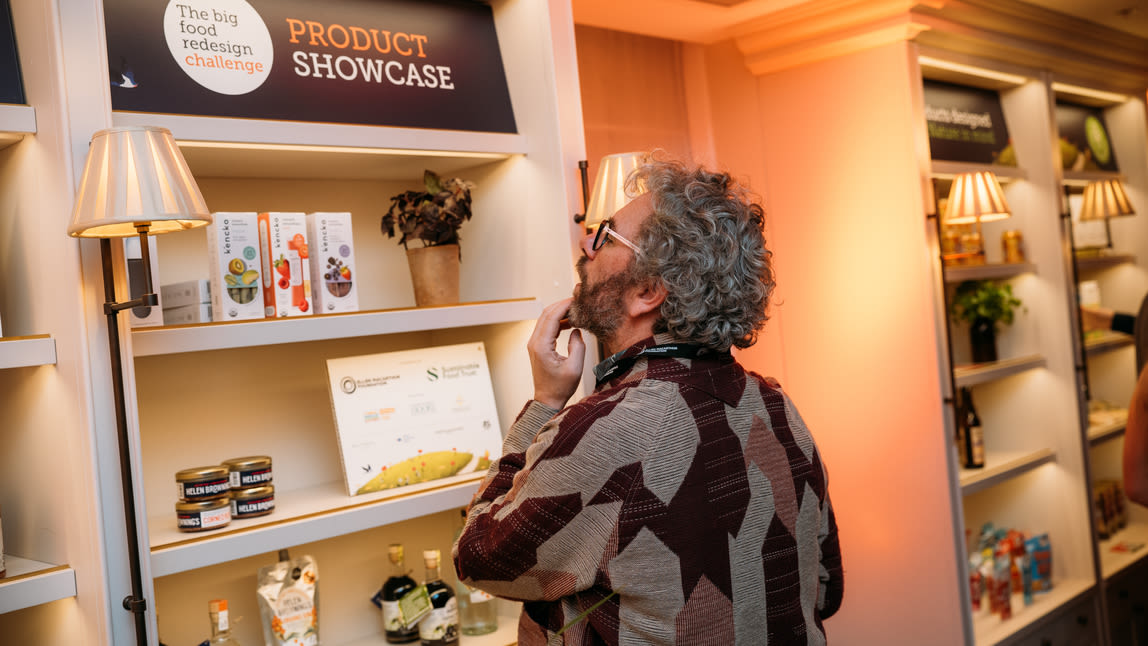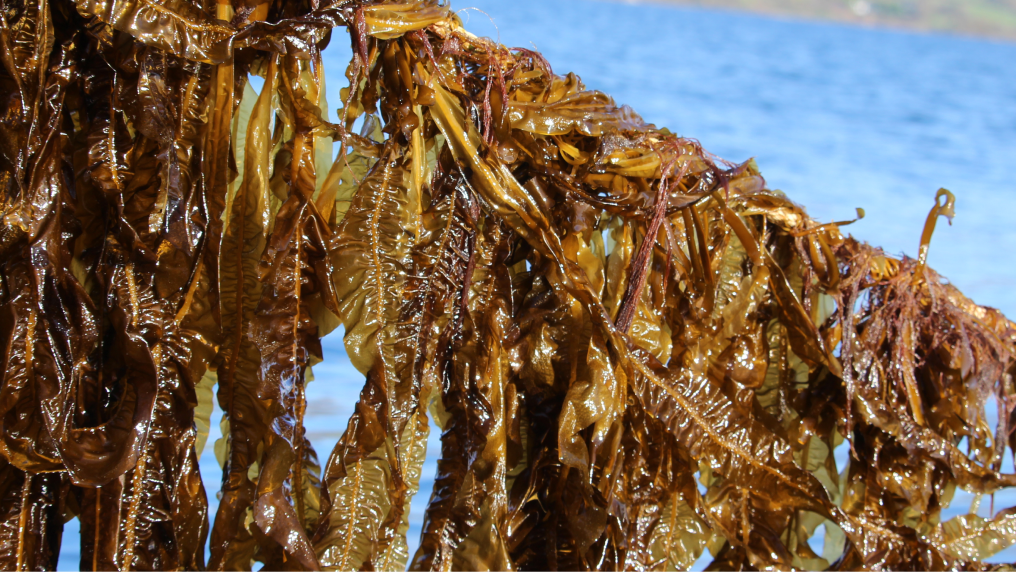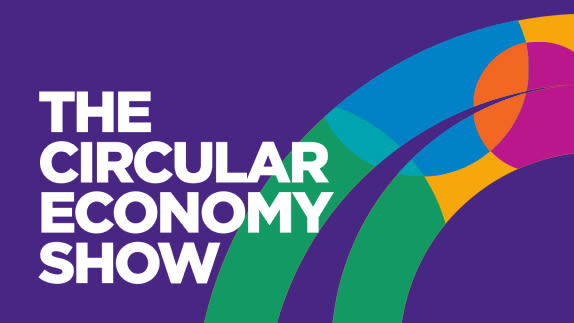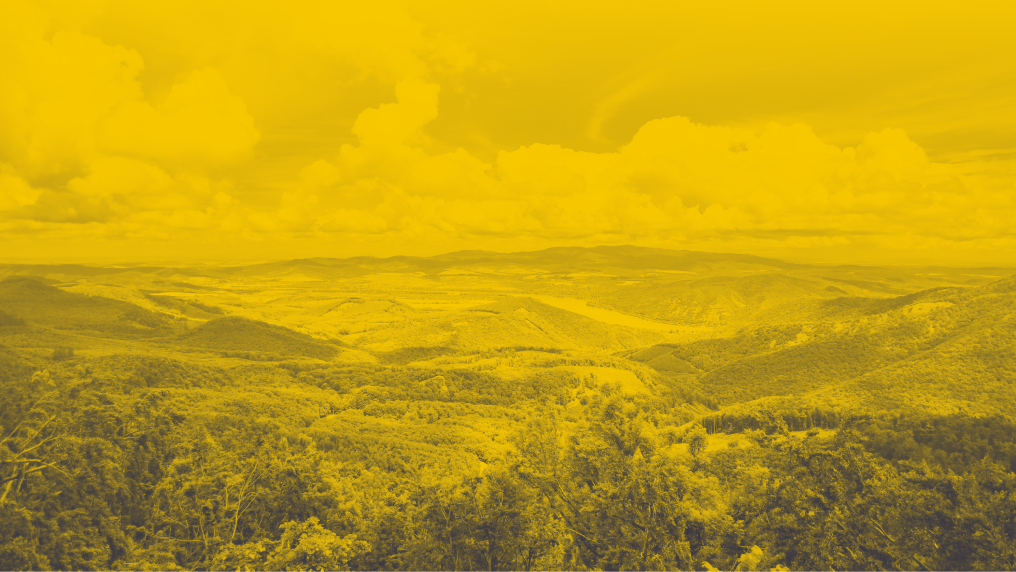The future of food is not predetermined – it's being shaped by the decisions being made today. This episode challenges food industry decision-makers to embrace a new vision for their businesses and the sector as a whole, whether your organisation is big or small. With insights from Rob Cameron, Global Head of ESG Engagement at Nestlé, and Sean Patrick, founder of Gabanna Foodworks, we examine the critical role of leadership in driving the shift towards a more diverse, resilient, and prosperous food system.
In this episode we discover:
How diversifying ingredients can transform food production and consumer choices
The power of collaboration between large corporations and agile startups to drive innovation
Strategies for companies to work effectively with farmers and suppliers to support nature and build resilient food systems
The potential for new processing technologies to support the use of a wider variety of crops
Examples of how businesses are creating new food concepts that are both nutritious and delicious
How circular design for food can help companies meet their environmental targets
Find out more about about the Big Food Redesign Challenge.
Listen on Spotify, Apple Podcasts, or wherever you get your podcast.
Transcript
[01:00:00.320] - Pippa Shawley Think about what's in your kitchen cupboards. If they're anything like mine, they're stacked with tins, jars and packets of pasta in various shapes and sizes. Those things have made it there via carefully planned supermarket shops, last minute runs to the convenience store and impromptu purchases made at market stalls on holiday. But who made the decisions about what to grow, how to create products from those ingredients and how to sell them? [01:00:27.040] - Pippa Shawley I'm Pippa, and in this episode we'll hear how two businesses, one a startup, the other a multinational corporation, are using the principles of circular design for food to shape what makes it onto our plates. Sean Patrick is the founder of Gabbana Food Works, a flexible processing platform working to bring more biodiverse ingredients into the food system and enable regenerative farmers to grow a wider variety of crops. Rob Cameron is global head of ESG Engagement at Nestle, which claims to be the world's largest food and beverage company with around 2,000 brands under its umbrella. Together, they sit at opposite ends of the food production scale. But we'll hear about the shared opportunities a circular design for food offers as both brands participated in the Ellen MacArthur Foundation's Big Food Redesign Challenge. [01:01:20.500] - Pippa Shawley I traveled to Amsterdam to meet Rob and Sean after they spoke at a recent event for the foundation's, which Rob refers to a couple of times in this conversation. I started by asking Shaun what problems he was trying to solve when he founded Gabbana Food Works. [01:01:38.240] - Sean Patrick I'm originally from Uganda, where I grew up. For me, food was supposed to be very diverse. And then I come to Europe, that's 20 years ago, and you have very select types of vegetables you can eat, different grains you can eat. So Gabbana. What I realised was we have to eat more variety, both for ourselves as people, but also for soil, for the nature, because we have to plant more things. So he realised that people are interested in eating different things. They want to eat quinoa, they want to eat teff, but they don't know how to prepare it. So the idea is, what if we can use all these different plants and crops and transform them into food concepts that people can easily adopt into their daily eating habits? So that's what we're doing. We're doing pasta, but we're also working on breakfast cereal, working on pastry, and in that way it's an easy access tool. So it's a product, you know pasta, you know how to eat it, you know how to cook it. So you can't say, I'm not going to eat sorghum pasta now. You say, okay, either you like it or you don't. [01:02:39.510] - Sean Patrick So if the quality is good, the assumption is that people enjoy a quinoa pasta, they will enjoy a lupine bean and amaranth pasta. Yeah, so that's kind of the idea. [01:02:49.330] - Pippa Shawley So you're not trying to take them too far away from what they've already eaten. [01:02:52.370] - Sean Patrick Yeah, exactly. Because that, the barrier to adoption, I think, is the unfamiliarity of things. So why people still eat the same thing is because, yes, I know that I grew up on that punt, but now we're saying maybe you can actually eat something else, but then in a format that you know. Yeah. And that makes it easy for people to say, okay, you know what, I'm going to try something else. I'm going to expand. The last company I had, which was like, you can imagine, like beetroots. Most adults beyond, even kids, don't like beetroot. But then if it's a beetroot pasta, they're like, okay, I'm going to try it and if the test is okay, I will eat beetroots. And then after testing it, they're like, oh, actually didn't test the beetroot, so I'm going to eat that. And that is what we're trying to really do, like make it easy for people to adopt all these different varieties of things being grown by the region farmers. [01:03:46.030] - Pippa Shawley Yeah. And Rob, I heard you saying yes to a lot of what Sean was saying there. But I feel like maybe one reason that people buy the Nestle brands is because they are those things that they've eaten since they were children. So how does a circular design for food work in an established company like Nestle? [01:04:01.580] - Rob Cameron Yeah, it's an interesting question. And I was saying yes, because I think what Sean's talking about is that generally speaking, the market for a product that's circular just because it's circular is very, very small. You know, consumers buy products based on taste, they buy on convenience and they buy on price. And what you're talking about, Sean, was very much along those lines that you, it tastes good, it doesn't really matter where it comes from, it just tastes good. But for us, I made the point in the plenary this morning. There's so many examples of circularity that existed before circularity was invented, if you see what I mean. We talked this morning a little bit about coffee, for example, where what we understand is a product that's all around convenience. Freeze dried instant coffee. Actually that product is a result of innovation back in the 1930s where Brazil had a huge surplus of fresh coffee which was all going to go to waste if there wasn't some way of processing it. And the Brazilian government approached Nestle and said, you know, you've got some smart technologists there. Could you help us figure out what we should do with this coffee? [01:05:04.660] - Rob Cameron And that's where that innovation came from. You know, that was in the 1930s. I think more recently there's been these big staging posts. If you look back over the course of the company's history. One of the big staging posts was in the early 2000s when there was some thinking around, well, what does it mean to be responsible? What does it mean to adopt corporate social responsibility practices as was talked about in those times? And the company looked at this idea of creating shared value and articulated a way of doing business through this idea of creating shared value that I think was very much founded on the values of the business, but actually took the company a step forward in terms of how to express it. And you would find, if you looked at the literature around that time, you know, A, there was an academic basis for it, but B, there was a lot of talk by the senior, the most senior leadership on what it meant to be a company that creates shared value, meaning we cannot thrive unless the communities in which we operate are thriving. And that's been expressed through the investments that Nespresso has made in thriving communities of origin for coffee. [01:06:14.700] - Rob Cameron Same now with Nescafe. We're doing that kind of work with Coco and have done for many years. You know, that idea of, you know, we need to be part of thriving communities, then you come forward again to take it through to the more recent past. And the idea of circularity comes through very, very strongly associated with our net zero ambitions and also with the ambitions we launched at the same time, which was the full scale pivot to regenerative farming practices. And we in Nestle, it's true for Sean's company and it's true for many companies, I'm sure that we are dependent on agriculture and we all know agriculture is both a significant cause of emissions on the one hand, but also a cause of some significant degradation to natural environments and can be a cause of the solution, a source of the solution. So a cause of the impacts, but a source of the solution. And we see regenerative farming practices as being the most significant change we can make. If we can help farmers from whom we buy to adopt those farming practices provides more resilience for them, provides more resilient value chains for us, so we can see a long term benefit and we think that it will lead to better outcomes for everyone. So that's a big, big shift that we're engaged in right now. [01:07:35.630] - Pippa Shawley And you're saying we there. I wonder if you can give us a little sense of how that's worked within Nestle, particularly beyond the ESG team. [01:07:45.860] - Rob Cameron Yeah, well one thing to say is that Nestle, we have a relatively small team working exclusively on sustainability. It's very slim line. And the reason for that is because it's back to this idea of distributed management. The management model of Nestle is quite distributed. Everything is pushed out and the markets, the countries in which we operate have a high degree of control over their own operations. So we're quite decentralized in that regard. But the thinking is that we didn't even have a chief sustainability officer until relatively recently. We do have a couple of things going on. One is very strong governance. So there is a sustainability committee of the board and a very strong executive sustainability committee. And the idea of that again is distributed responsibility to make this work and then goes out into the field. And I think there's a kind of pride in the business. I talk about we a lot. I mean Nestle, as you say, is a big family. There's 275,000 or so people involved. And then the value chain that we buy from, the idea is that it becomes as much a part of how we do business. So nutrition, health and wellness is the what creating shared value is the how we go about our business, regenerative agriculture and the other so much I could say about human rights and livelihoods. That's how we do business. And those are expressions of how we want to create shared value. [01:09:10.060] - Pippa Shawley And Sean, what's your value chain like and how do you get the buy in for? I mean is it inherent in everything you do and your partners do around sector design for food principles? [01:09:23.220] - Sean Patrick Yeah, it is like the backbone of Gabbana because we are trying to look at it both on the supply chain in terms of sourcing ingredients, but also in terms of the products we make as well. So our goal is to have multi ingredient products because there was a trend I think a couple of years ago of like a singular ingredient concepts. So you had lupine pasta or you have only one grain durum gragnano pasta from somewhere. And for me that I was like no, because different plants have different properties. So if I can find different plants that have the right properties and physiochemical characteristics to create the right taste and texture, I think I'd rather do that rather than trying to have highly processed ingredients to create the same thing. So ideally, it makes sense to kind of work with what nature is making, because you have psyllium does one thing, you have this protein, does that thing, you have that grain does that thing. So at the end of the day, working with the natural capabilities of these plants and crops, we're able to create products that have the right tastes and textures and mouthfeels and all that. [01:10:36.790] - Sean Patrick And plus the nutrition side of it. And on the supply side, we're working with region farmers now that are already in the process being really small. We can't, for instance, go to other farmers and take them through the whole transitioning process, because that's a very expensive process because we can't commit now to say, okay, you transition, we are going to buy everything you do. So for us, that's a very high risk to take on. Now we are saying, okay, you're already transitioned, you're the region farmer. What are you growing and what can we buy? But also, what I notice now is more farmers are coming with questions like, hey, what can you do with my stuff? A few days ago, there's a company in the Netherlands called La Calupino. They are trying to introduce lupine bins into the Netherlands. And they were doing the typical bean pots, so, like bins in the liquids. But then they came to us and we had a chat and I was like, we can actually make pasta with your beans. Lupin is an interesting bean. So we did a pilot for them. They took it. Now they want to present next week. [01:11:44.440] - Sean Patrick Okay, we take off a small batch and our batches are so small to enable this fast transition to, okay, I want to have an actual product as well, even if I'm a farmer or I'm a small brand. So the ability to have flexible processing and small batch capacities to produce at the same quality. We want to get these farmers into this new kind of pipeline or into this new supply chain where they are not just suppliers of intu, but they're actually actively participating in the food supply chain, both as suppliers, but also as active economic participants into the food supply chain. [01:12:23.230] - Pippa Shawley It sounds really empowering for the producers. [01:12:26.860] - Sean Patrick It is. It is interesting and scary for them. But I notice more and more are starting to kind of get ambitious about it. And it's particularly because of the market, because on the local markets where they are, people are more and more interested in what's available within my neighborhood. Because if a farmer says, hey, I have this cheese, we are making this new cheese, it's more likely for the neighbors and the cafes and the restaurants in that region to say, okay, let's try your cheese. Because if something happens or it's not really good, they'll just come back and say, I don't really like it that much, maybe change this or add something and then this innovation within the community kind of happens because they know the farmer, they know what they're doing. If it's a local brand, it's a small brand, they know exactly who it is, who to talk to. So we are seeing this kind of shift happening within region farming space of this desire to actively participate into food and creating new foods. [01:13:28.370] - Pippa Shawley It sounds like there's a really good mixture there of agility and scale. So you can keep developing whilst the word of mouth spreading is happening. [01:13:40.460] - Sean Patrick It does, yeah, yeah. Because for, I think in our space as a small company, we can't do the marketing level of Nestle. Absolutely not. So we can only do word of mouth and just people trying and engaging with the products we're creating. I think one of the interesting things, particularly for the new, for the big companies, is how can we make R and D accessible for smaller players as well? Because we have to go through a whole R and D process because a farmer comes with different grains and different things. So we have to go through that process. Okay, what can this do? Can it perform well? Can we create a product with it? And that allows them to have this trust of, okay, I got this product, it's going to be liked by people because we are spending that time to create. And I think that has been the barrier for quite the long past of local products seem to be inferior. They seem to be okay. It's just, it's local and it's interesting. But you're not going to buy it the second time. Just buy it because it's a feel good thing. You're at the farmer's market, you pick some jam and it's nice. [01:14:50.240] - Sean Patrick But qualities may be. So, we're trying to say no. We can actually bring high level technologies at small scale and make it accessible to farmers, to small brands, to institutional catering to make sure they have locally produced and processed products and farmers can have good off take of what they're growing and harvesting. [01:15:15.080] - Pippa Shawley And Rob, can we talk about action? Because I think we talk a lot in the circular economy space about ideas. And as Sean says, not all companies have that huge R and D budget or that huge marketing budget. What power does Nestle have and how are you pushing through change in Nestle? [01:15:34.090] - Rob Cameron Well, there's a couple of examples. So not many people know this, but we actually source from something like 600,000 farmers directly. Many of those are dairy farmers. So we actually do have direct touch points at farm gates, sourcing directly from farmers. So that gives us good visibility on farmers situations. In the case of dairy, Dairy, for instance, through the value chain. Actually, in the case of dairy in uk, for example, we have a dairy supplier called First Milk, which is a big network of farmers, and we've worked incredibly closely with them and using them as an aggregator because they can get across many, many farmers that we can't get to. We're not buying directly from the farmers necessarily in all those instances, but the First Milk network, through them, we can work very closely with farmers. And whether it's. In the case of dairy, which is one of our big impact areas of whether it's agroforestry, tree planting, hedge planting, whether it's mob grazing, where the cows are moving from part of the field to another part of the field, you know, we've got the technology to understand the impacts of these things. We can support with COVID crops, for instance. [01:16:41.500] - Rob Cameron We can pay premiums, of course, for regeneratively sourced products like dairy from First Milk, that helps the farmers make that transition. Then you look at, you know, take it to a completely different scale, and you're thinking about big trading companies like the Cargills of this world. And we have a big trading relationship with Cargill and working with them, they have the contact again with the farmers. Literally hundreds of thousands of hectares in North America for regenerative wheat that goes into the pizzas that we make in partnership with Cargill. So we use our buying power with those big traders. And what we're looking for is to find those traders that want to come on the journey with us. Same with the NGOs. I'll give you another example. So we've gone from a cooperative in the UK up to the big Cargills of this world. Then there's the NGOs that we work with. We've got super relationships with the likes of the Nature Conservancy, for instance, that help us directly on the ground in places like many places around the world. I can think of Columbia as one example. And then the other area, which I think is really interesting, is where we can use our power in the Value chain. [01:17:46.890] - Rob Cameron For sure, we can work with NGOs in the communities that we source from. Absolutely. Another thing we can do, though, is we've got a voice. We have a voice in Nestle. So we can work with others, like for example, that we're non competitive with, but we want the same things. So here's an example. Again, go back to the uk, the Lens Landscape enterprise networks. This idea of landscape thinking is really interesting, where you get the different parties who have an interest in a particular landscape. In the case of the UK, PepsiCo obviously wants potatoes for crisps. We're looking for typically wheat for shredded wheat. Say a company like Diageo is looking for malt and barley for its drinks. Now many farmers are now going back to rotational farming. But if we're asking the farms to do the same things, the same practices, you've got a buyer for the wheat, that'll be us. Then you've got a buyer for the barley, that will be Diageo. Then you've got a buyer for the potatoes and then put some livestock in there as well. And you've got back to that whole thing of nicely balanced farming with good regenerative practices, where we're looking for the same things from the buyer. [01:18:59.080] - Rob Cameron They may want different things than what we want, but we're looking, looking for the same practices. And that creates scale and more security. [01:19:05.100] - Pippa Shawley For farmers as well. [01:19:05.930] - Rob Cameron Look, this is all about secure livelihoods. And one of the things I'm really concerned about in what you might call, we call it the circularity world or the sustainability world is we keep talking about sustainability as if it's an end state or circularity as an end state. This is not an end state. I think circularity and sustainability are tools, means to get to where we want to get to. What we want to get to is thriving communities with resilient farmers, resilient livelihoods where jobs are created and supported and people feel as if they can fulfill themselves. It's that kind of, you know, it almost sounds a bit too motherhood and apple pie, but it's that kind of, you know, thriving people living on a thriving planet is what we're seeking. Circularity is a means to that end. And I think we've got to be quite thoughtful about that in how we communicate. [01:19:57.110] - Pippa Shawley I think you've anticipated my final question, which was what do you really want to see? But maybe, Sean, you can do that for us. So that's Rob's vision of wanting this world that works for everybody. In terms of food companies and driving that change, what do you want to see happen? Probably in quite short term work. [01:20:18.530] - Sean Patrick I think on my end it's more the reformulation of how we create food products. So the reformation towards more biodiversity coming into, into food because if we're looking at, I do talk to some of the plant based milk people and was like, why is oat milk only oats? Yeah, imagine you had oats and something else because you need your creaminess, you need your protein, you need your emulsification. All this can come from so many different plants. So I'm always curious like why that doesn't happen. I do understand why some of the technical processes and the line processing, but I think we can do better because if we can send, I don't know a thing to the moon, we can build a processing line that is able to handle diverse ingredients. And I think to me that's something we need to see happening more and more because we have every imaginable plant on the planet available. Why don't we use them in the products we're creating? So, so creating new food concepts with biodiverse rich ingredients. I think for me that will be an interesting future because test is going to be better, nutrition is going to be better and the farmers are just going to keep churning out all kinds of new stuff. [01:21:36.980] - Sean Patrick And we can do that today. There's no reason why not. It's just we are happy with how things are, but I think gradually we should switch a little bit to something else. So if we can do that, that would be great. [01:21:50.470] - Pippa Shawley Sounds like both of you are saying that we need more imagination but also more ambition to get us to the next point. Thank you so much for joining us today. Unfortunately we're out of time, but it's been really great to chat to you both. So thank you. [01:22:02.900] - Sean Patrick Thanks for having us. [01:22:03.730] - Rob Cameron Thanks for having me. [01:22:04.160] - Sean Patrick Thanks for having me. [01:22:05.230] - Pippa Shawley Better food, better nutrition and better farming practices. Sean nicely summed up the outcomes he sees circular design for food having for people and the planet. You can find out more about circular design for food and the outcomes of the big food redesign challenge in the show notes. Thanks for listening. If you liked this episode then please help spread the word by sharing it with your network. See you next time.

Want to stay up to date?
Subscribe to our newsletter to receive news from across the Ellen MacArthur Foundation, including the latest updates on our work in food.






